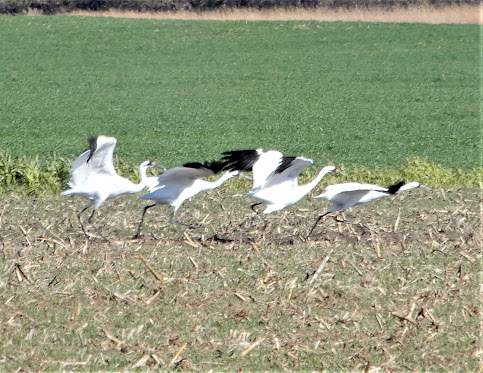Whoop! Whoop!
Whooping cranes have been visiting in our area for the past week or so. A group of six has stayed about half a mile from the road on farm ground most of the time. My little camera can't handle that distance, though I've given it the old college try several times.
 |
| It's blurry, but if you know what you're looking at, you can tell they are whooping cranes. |
But as fate would have it, they were just a bit closer to the road as we drove by one day last week.
Randy has become quite compliant with my requests to hold still and smile for yet another photo. Kinley and Brooke have also grown used to Grandma's constant need for them to pose for the camera and flash their smiles.
The whooping cranes evidently didn't get the memo about being "pose ready" at all times. They didn't take time to smile for the camera before launching into the sky. But it was still a spectacular sight.
The Whooping Crane is the tallest North American bird at 5 feet tall and has
a 7- to 8-foot wing spread. Adults are white with black wing tips and a red
face. Young may be whitish gray with rusty wash color on their head and
neck and scattered reddish brown feathers over their back and sides, according to the National Wildlife Service.
We are only a couple of miles from Quivira National Wildlife Refuge. Whooping cranes have been spotted there, too. I'm not sure whether these are the same group or a separate one.
I made this collage from photos taken at Quivira's Education Center in 2013. Kinley and Grandpa were my models at the time.Last year, we had the visitors on some of our farm ground, and they were closer to the road a couple of times.
 |
| Photos from 2020 |
Whooping
Cranes are regular spring and fall transients through our part of Kansas, generally
passing through the marked corridor in March-April and
October-November. (For a link on where they've been seen this fall, click here.)

Preferred resting areas are wetlands in level to moderately rolling terrain away from human activity where low, sparse vegetation permits ease of movement and an open view. During migration, cranes feed on grain, frogs, crayfish, grasshoppers, fish, crickets, spiders, and aquatic plants. (From NWS)
I found this YouTube video on the cranes.
***
NOTE: This may be the only thing I get posted this week. We have been doing cattle tasks since last Saturday. More on that to come! And maybe, if I get lucky, I'll have more whooping crane photos to share later, too.







Enjoyed! What a world class experience!
ReplyDeleteThanks, Marty!
DeleteMagnificent birds. How wonderfu to see them visit each year.
ReplyDeleteEven though they are half a mile away, they stand out!
Delete